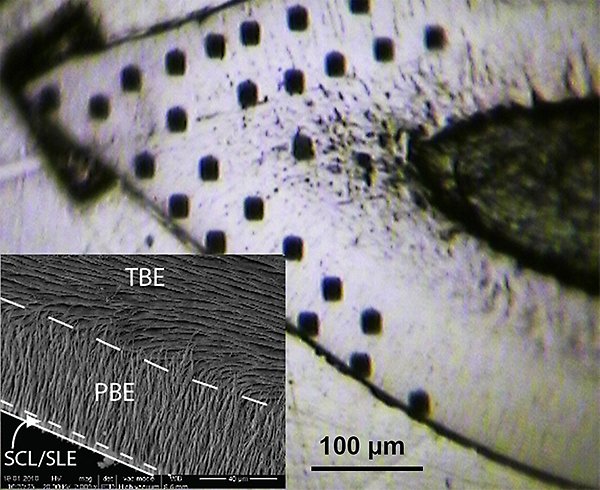Pågående forskning
Endast tillgänglig på engelska.
Swedish Research Council Young Researcher’s Starting grant (2015-2018): “Oxygen isotopes as proxies to palaeoclimate: environmental vs. physiological signal in aquatic vertebrate biominerals”
The major purpose is to establish the applicability of stable isotope signatures in modern and fossil aquatic vertebrate biominerals as a reliable tool to explore ecology, environment and climatic changes of the past. Dr Žigaitė applies state-of-the-art micro-beam analytical techniques, such as the Nordic secondary ion-microprobe at NordSIM-laboratory and “Vegacenter” micro-analytical and imaging facilities at the Department Geosciences, Swedish Museum of Natural History. Ultrastructural examination and imaging of teeth, as well as chemical preparations of biomineral for different types of mass-spectrometry are performed using high-end laboratory facilities at the Department of Organismal Biology, Uppsala University.
Uppsala University Department of Organismal Biology Young Principal Investigator’s grant for a PhD project (2015-2019): “Trace fossils as palaeobiological and geochemical archives”
Dr Žigaitė supervises a PhD project on geochemical archives in terrestrial trace fossils, which aims to decipher the palaeobiological and palaeoenvironmental record in late Palaeozoic and Mesozoic terrestrial vertebrate trace fossils, using a combined approach of: (1) 3D structural reconstructions and (2) isotopic and elemental biogeochemistry. Major objectives are to trace and distinguish the patterns of change in vertebrate biology, physiology, as well as their ecology and environment during one of the most important times in tetrapod evolution, global aridisation of the climate and expansion of terrestrial ecological niches. Application of advanced analytical methods and technologies, such as 3D synchrotron tomography and in-situ micro-beam techniques for mass-spectrometry form an essential part of the research. Project lead in collaboration with Dr Grzegorz Niedzwiedzki and Prof Per Erik Ahlberg (Uppsala University).
National collaboration
Research collaboration with Prof Martin Whitehouse at the world-class Nordic secondary ion micro-probe facility at the NordSIM-laboratory (Swedish Museum of Natural History) has resulted in successful development of the SIMS-oxygen analyses method on the dental bioapatite of shark teeth (Žigaitė & Whitehouse 2014; Žigaitė et al., in prep). The NordSIM is based around a Cameca 1280 ion microprobe, an advanced mass spectrometer, which allows direct in-situ measurement of isotopic and elemental composition in selected micrometer sized areas of a sample. Analytical collaborations has been equally initiated with Dr Ellen Kooijman at the recently opened “Vegacenter” micro-analytical facility (Swedish Museum of Natural History) for the quantitative imaging and in-situ elemental analyses of apatite biomineral at the micron to sub-micron scale. Both instruments represent state-of-the-art in the field of micro-beam analytical geochemistry, and are in part funded by the Swedish Research Council.

Targeted in situ ion microprobe sampling of the enameloid tissues (in a Sandbar shark tooth section at the NordSIM-laboratory. From Žigaitė & Whitehouse 2014.
International collaboration
UK
Over the last few years, including my research time as a Marie-Curie Research Fellow at the University of Birmingham, I have developed strong collaborations with a number of colleagues in Great Britain, Natural History Museum of London in particular. Prof Teresa Jeffries at the Analyses Center of the Earth Science Department became major collaborator for the in-situ REE and trace element analyses, (Žigaitė et al. 2015; Fadel et al. 2015); Prof Moya Meredith Smith, Dr Zerina Johansson and Dr Martha Richter provided access and introduction to the outstanding NHM fossil vertebrate collections, as well as incentive collaboration on the early vertebrate dental tissue development (Žigaitė et al. 2013). Work with Ass Prof Alberto Pérez-Huerta at the University of Glasgow (currently - the University of Alabama, USA) resulted in new approaches identifying vertebrate biomineral properties (Žigaitė et al. 2014, 2015; Fadel et al. 2015; Žigaitė et al. in prep).

Crystallinity imaging via Electron Backscattering Diffraction (EBSD) with scanning electron microscope (SEM), from Žigaitė et al. 2014. The dental scale section of the Devonian fossil thelodont demonstrates the recrystallization of the central pulp cavity, replacing primary soft tissues.
France
Since my doctoral research at the University of Lille-1, I have established solid collaborative network with CNRS and university researchers at the “Géosystèmes” group (Dr Thomas Servais, Dr Alain Blieck, Dr This Vanderbroucke) as well as researchers at the Paris Museum of Natural History (Prof Daniel Goujet, Prof Gaël Clément), resulting in fruitful collaboration in the areas of Palaeozoic climate research, vertebrate palaeontology and biogeography, and integrated bio- chemo- and cyclo-stratigraphic approach to gloabal paaleoenvironmental changes (Žigaitė & Blieck, 2006; Žigaitė et al. 2008; Verniers et al., 2008; Žigaitė et al. 2011; Žigaitė & Blieck 2013; Žigaitė et al. 2013a,b).
Germany
Long-term established collaboration with Prof Michael M. Joachimski, who is one of the most experienced and internationally recognized isotope geochemist at the Stable Isotope Laboratory at the GeoZentrum Nordbayern (University of Erlangen-Nuremberg), provided high-pecission phosphate-oxygen isotopic measurements and contributed to conclusive findings on isotopic behaviour of variuos groups of fossil vertebrates as well as Palaeozoic seawater temperatures and plalaeoclimate (Žigaitė et al., 2009; 2010; 2014; in prep). Ongoing collaboration with Ass Prof Thomas Tütken (University of Mainz) focuses on geochemical signatures as proxies to their palaeobiology and palaeoenvironment in Mesozoic aquatic vertebrates (Žigaitė, Kear et al. in prep), as well as non-traditional isotope proxies and multiple-proxy approach to questions of vertebrate physiology and environment.
